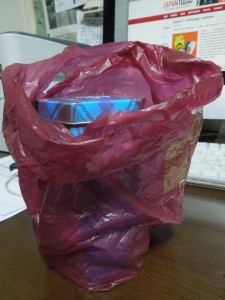Many aspects of Japanese culture are closely tied to Shinto, and it turns out that omiyage (Japanese souvenirs) are a case in point. In Japan Today a cultural anthropology professor sees the custom of giving omiyage as unique to Japan, and he identifies the roots as lying in the pilgrimage customs of the past. (For the full article, click here.)
***********************************************************

Omiyage - sometimes a surprise, and sometimes even delicious
Don’t they have omiyage abroad?
Omiyage is translated as “souvenir” in English, but the two are a little different. A souvenir is something that the person who is doing the traveling buys for him/herself to remember the trip. In Europe and the United States, train station and airport stores are filled with key chains and other non-food items for this purpose. But Japanese omiyage typically consists of food items produced in the area the trip was taken in. Also, omiyage is not intended to be consumed by the traveler and is instead given out to coworkers or friends…. in Japan, omiyage is associated with the history of a specific region, for example, Ise City’s Akafuku rice crackers or Gunma Prefecture’s famous Kusatsu Onsen mochi. In general, this is not true of omiyage elsewhere.
So when was omiyage first seen in Japan?
The origin of omiyage is unclear, but it is thought that the custom began in association with sacred pilgrimages. Those who visited Shinto shrines were expected to bring back evidence of the pilgrimage to their families in the form of charms, rice wine cups, or other religiously significant items. It was thought that the protection granted to pilgrims would be transferred to whoever received the items brought back from the sacred trip. This is said to be the beginning of omiyage.
So at that time, manju (steamed yeast buns with filling) and other foods that are commonly purchased as omiyage today didn’t exist?
Back then, food preservation techniques were limited and people traveled by foot so they could only carry light items such as medicine, money, and ear picks. There was only room for the essentials.
Does that mean that the types of food products increased once the railway system was built?
That’s right. For example, Shizuoku Prefecture’s Abekawa mochi originated in a small tea house next to Abekawa River. After the development of the railway system, “gyuhi,” a sugary gel confectionery, was made instead of mochi (rice) because it lasts longer and can be taken on long trips. At first, many people complained about this new style of Abekawa mochi, but it eventually became known as a specialty product associated with the area.

Leave a Reply